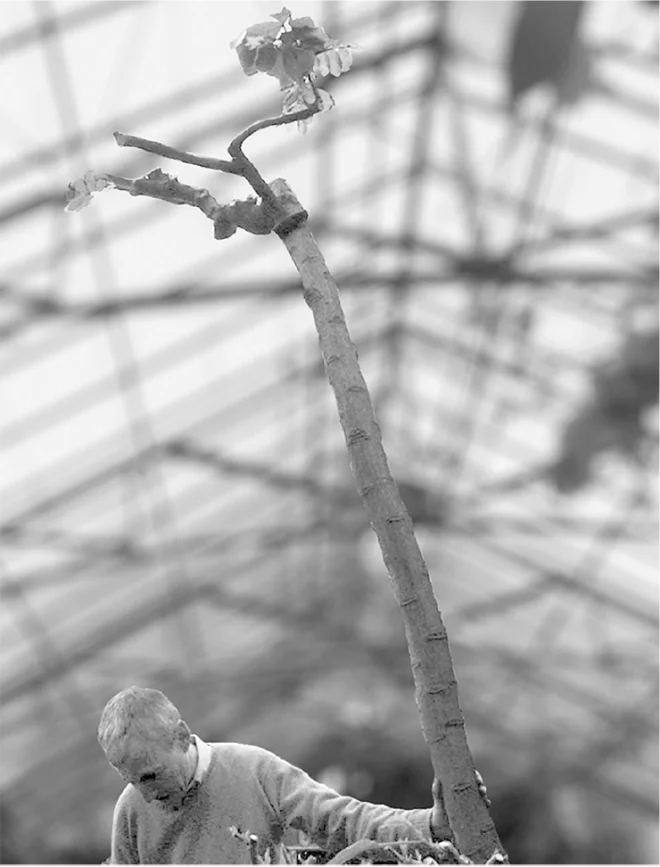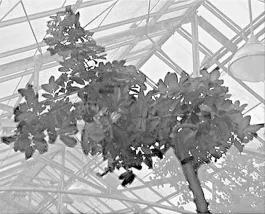
I love trees—and all plants. You probably love them too. By listening to them, I have come to know hundreds of trees and other plants as individuals. When they are sick, I help them heal themselves. I love each of them as if they were my children.
When you put your hands on a tree, you feel the bark. When I touch a tree, sure, I feel the bark, but I also feel the tree’s Life Force flowing through it. I feel a rush of power or current moving from the roots to the branches. This power or current tells me details about the tree’s inner health in ways that conventional science and technology cannot.
People started calling me “The Tree Whisperer” when I went to their properties, touched, and saved their precious trees. Some people had already tried conventional approaches that were unsuccessful. I holistically heal the life processes of plants using bioenergy-based, hands-on healing methods. I apply no products whatsoever.
In the early days of developing my systems, trees and other plants taught me that stress factors are additive for them and that three or more stresses can lead to their decline. After three years of research and development, I started doing this methodology professionally. Not long afterward, my business partner, Basia Alexander, and I created the Tree Whispering workshop and started teaching.
People are accustomed to assuming that they know what is best for trees, but, in truth, they should ask trees about their inner health and about what they need.
You might be thinking, “Is he crazy? He’s talking about asking a tree!” No. I am not crazy. Both wilderness trackers as well as indigenous peoples have always known how to pay close attention to Nature. They pay attention to physical signs like changes in foliage or animal footprints, but—more importantly—they pay attention to their gut feelings and intuitions. We Westerners—who believe we are so advanced—need to cure our own insanity. It is crazy not to listen closely to Nature.
When I “whisper,” I am asking a tree what conditions must be corrected in its internal functionality in order to improve its health. Trees can’t always accomplish the change for themselves. It’s just like us—we might know about our own illnesses, but we can’t always heal ourselves.
I heal by establishing a personal rapport—like being “in the zone”—with the tree’s Life Force, by focusing my conscious intentionality, and by moving bioenergy flows within and around the tree. Since the turn of the century, many forward-looking hospitals have been offering energy medicine systems like Yoga, Reiki, Touch for Health, and Therapeutic Touch in their pro-grams for cancer, heart, and other patients.
How did I get started? I followed my childhood love of plants all the way through a bachelor of science in horticulture from Delaware Valley University in Pennsylvania to a masters and doctorate in botany and plant pathology from Purdue University in Indiana. I promoted plant health in my more than 25-year corporate career with Top 50 ag-chemical corporations.
But one thing stumped me. We knew that plants stopped growing when they were stressed. But we couldn’t do anything to repair their inner processes. We could only externally apply products on the symptoms. All we could do was kill the pests or throw around fertilizer, and hope that they would “grow through” it. We could not heal the plants.
I especially remember one visit to an Iowa farm. The soybeans there had sprouted and started growing well. Then the weather turned cold and wet. Those two-week-old plants turned yellow and stopped growing. The soybeans had locked up. In the meantime, the farmer could only wait patiently—perhaps for a couple of weeks—and hope the soybeans would survive until they could compensate inside themselves.
A solution for healing plants and trees from the inside out had to exist somewhere outside of the conventional mindset. I was determined to find it.
In early 2002, I attended an introductory talk by Dr. John Veltheim, the founder of the BodyTalk System®, a complementary energy medicine healing system for humans. Within the first hour, I asked myself, “Could these same ideas—proven to work in humans—work with plants?” I set out to discover the answer.
I studied the BodyTalk System. In the process, I realized and finally admitted that I have strong intuitive capabilities and sensory perceptive skills. When I am with plants, I experience knowings, sounds, images, colors, and fragrances as communications from them.
I started to develop my holistic system for healing trees and other plants. Three years of initial research and testing yielded results that were promising and sometimes stunning.
My very first clients were some rose bushes in my backyard. There were always a few weak bushes, so I started using my new biofield-based healing techniques on them. They revealed to me that feedback loops of functionality were broken between parts and systems that should have been interacting. I tried to make an internal repair by touching and tapping on them while—in my consciousness—focusing on certain combinations of internal relationships. The weak bushes got stronger and bloomed.
I graduated to crop clients and tree clients. Many of my customers started calling me “The Tree Whisperer.” When I lean close and put my hands on the trunk of a tree in order to feel its Life Force, I suppose it looks like I am whispering with it. Basia Alexander, my business partner, suggested that we go to public appearances and trade shows with a sign that said “The Tree Whisperer.” Initially, I was hesistant. But people’s reactions were so positive I embraced the moniker. ❖
Saving a Malaysian Tree in a Greenhouse
Basia and I were teaching a workshop in Toronto, Canada one spring. To practice some of the techniques, we led our students to a botanical garden’s greenhouse. The curator begged us, “Could you do anything to save this tree?”
The almost-bare tree was from Malaysia, a part of their tropical collection. I touched it and found there was still life in it. “Never too late to save a living tree,” I told her.
In the previous months, the Malaysian tree had undergone four major stress factors that the curator and I identified.
First, in the middle of winter, the building’s heating system went out, and the tree became bitterly cold. Second, someone had mistakenly added too much alcohol to their homemade insect spray. The soil this Malaysian tree was planted in was not optimal nor native to it. Poor soil made a third stress. Fourth, the staff really wanted the tree to survive, so everyone watered it—a lot. Overwatering is as harmful as underwatering.
When one stress factor occurs, the plant’s natural feedback loops compensate. This compensation is usually not visible to us. Then a second stress factor comes along. The effects of a double compensation are sometimes visible.
By the time the third or fourth stress factors come along, the tree can no longer adapt and starts to decline, looking sicker and sicker.

The tree is trapped. It cannot find a clear path around the blocked feedback loops. So it eats up its own resources. When it has no more food left, it dies.
But surgery can’t be done on a tree’s circulation like a stent implant or heart bypass can be done on a person. That’s why my hands-on bioenergy healing techniques fit so well with plants. When inner functionality is repaired bioenergetically, there is a reversal of the eating-itself-up downward flow of energy. The compromised parts and systems that can work again do. Then growth drives healing, which then drives more growth, which can then drive more healing, and on and on.
When I stood with the Malaysian tree in Toronto, I knew that first its xylem and phloem needed repair. Then the ability of the tree to get water and nutrients from the roots up to the growing points or leaf buds had to be restored, while reestablishing the tree’s ability to produce food.
At this point, something took me by surprise. Luckily I was still holding the tree (shown in the photo at the top of this page). In my deep sensory perception, I felt the tree shift its energy upward. It reversed from pulling in life energy to pushing out life energy—and I felt it immediately.
The tree wanted to grow again!
Before we left, I gave the staff a couple of pieces of practical advice: “Don’t water it so much,” and “Be patient.”
Several months later, I headed back to Toronto. When I got there, the Malaysian tree was flourishing. Only the skeletons of a few sick leaves were still there among the lush new canopy. The curator told me the tree seemed to just sit there for many weeks. “Then all of a sudden it went woosh.” She threw her arms apart. “New leaves came out like crazy. It began to flourish again. We were all so happy!”
How to Get Intuitive Messages from a Plant
A beginner’s exercise.
Try This Mindful Exercise: Create a Breathing and Transmitting/Receiving Cycle. A few tips: Use heighted awareness of any or all of the five physical senses. Engage your emotions and intuition without inhibition. Listen to “the little voice inside,” see with “the mind’s eye,” and comprehend what your heart tells you. Ask “yes” and “no” questions, and allow the answers to come into awareness.
Now read through these steps and decide whether you feel comfortable doing the exercise. If you do not feel comfortable, do not do it.
Step 1: Go to a tree, and put your hands on it. Close your eyes, if you’re comfortable doing so.
Step 2: Imagine a stream of air coming into your heart area from the tree and going out your belly area back to the tree. This stream of air creates a connection cycle.
Step 3: On the incoming stream of air, imagine the Life Force and bioenergy of the tree connecting with you.
Step 4: On the outgoing stream of air, imagine your Life Force and bioenergy connecting with the tree.
Step 5: Continue to make the cycle of connection for a few minutes: The tree’s Life Force is coming in at your heart area, and your Life Force is going to the tree from your belly area. It’s a mutual exchange of caring or love.
Step 6: Imagine that the tree is a transmitting tower that is sending out something like radio waves in all directions.
Step 7: Imagine that you are a radio receiver and that you can tune to the station and receive the tree’s waves.
Step 8: Imagine the reverse. You are a transmitting tower and the tree is a radio receiver, receiving your waves.
Step 9: Imagine that the tree and you are making a circular, two-way, transmitting-and-receiving cycle.
Step 10: Breathe in and out easily and gently. Allow yourself to enjoy this cycle for several minutes. Open your awareness to any message that the tree might be transmitting to you. Then transmit a message of kindness or love to the tree.
Step 11: Realize that your connection allows you to come from the tree’s point of view and to know what its life is like.
Step 12: Thank the tree for allowing you into its world. Write down a few brief phrases to remind you of your experience. Let the words flow from your heart.


 Previous
Previous

